Business Communication Report: Legal, Ethical, and Operational
VerifiedAdded on 2020/01/07
|11
|2912
|191
Report
AI Summary
This report provides a comprehensive overview of business communication, exploring various types, their origins, and purposes. It delves into verbal, written, and on-screen multimedia communication methods, using ASDA as a case study. The report covers the production of corporate communications, evaluating external communications, and explaining legal, ethical, and operational issues related to business information. It also outlines electronic and non-electronic communication methods, such as email, phone calls, and SMS, while considering the associated costs and organizational policies. This report aims to provide insights into effective communication strategies and their implications within a business context, providing practical examples and relevant legal frameworks.
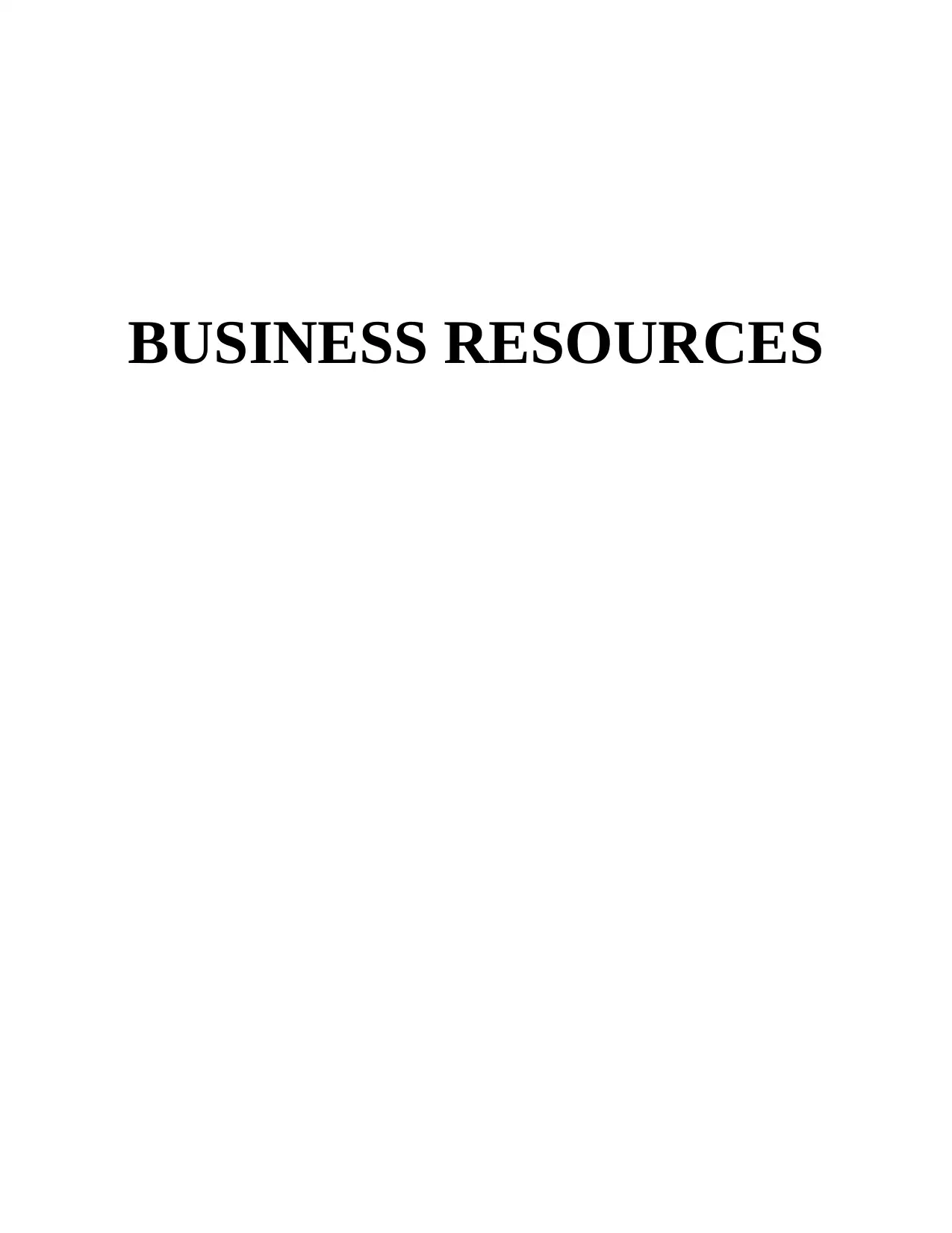
BUSINESS RESOURCES
Paraphrase This Document
Need a fresh take? Get an instant paraphrase of this document with our AI Paraphraser
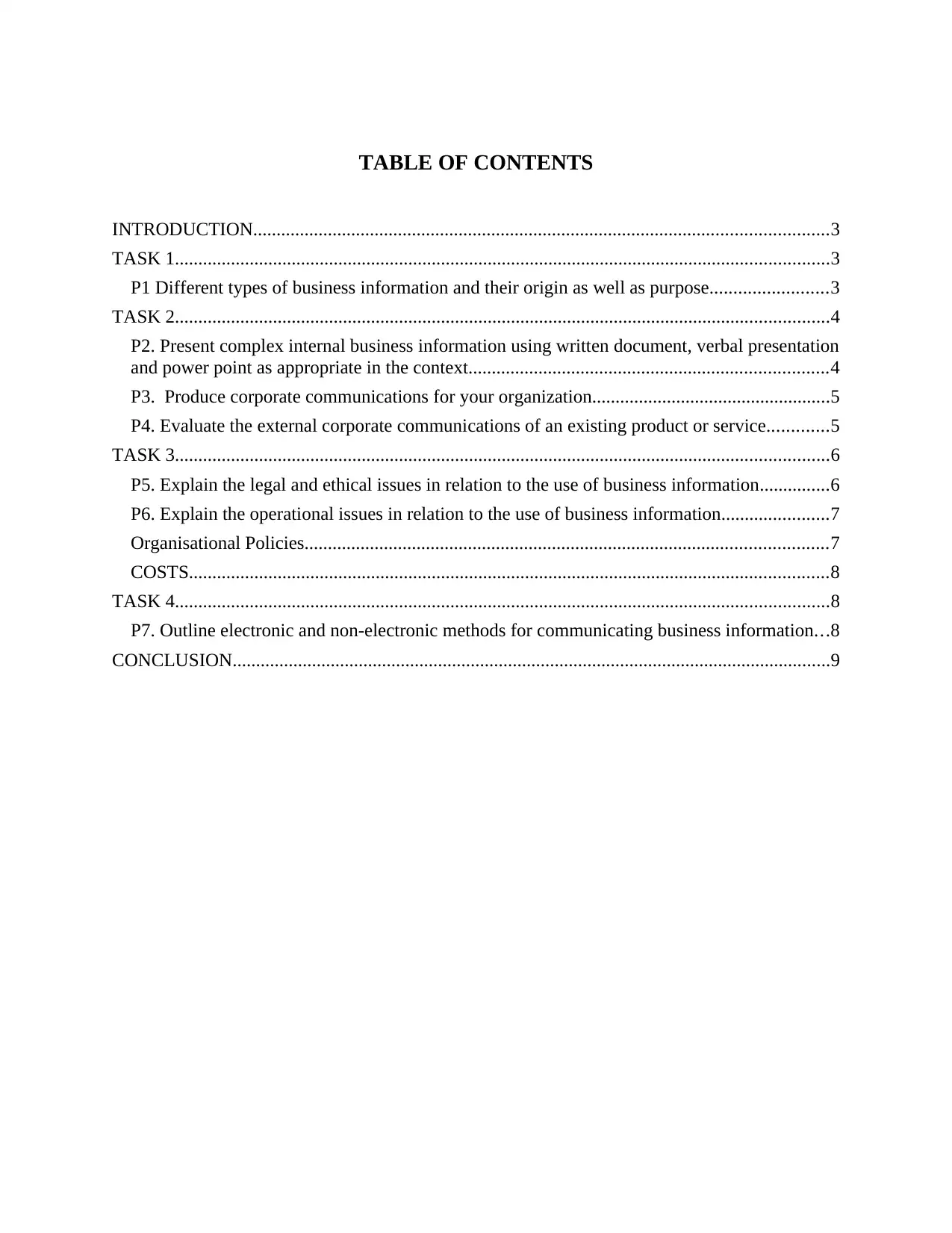
TABLE OF CONTENTS
INTRODUCTION...........................................................................................................................3
TASK 1............................................................................................................................................3
P1 Different types of business information and their origin as well as purpose.........................3
TASK 2............................................................................................................................................4
P2. Present complex internal business information using written document, verbal presentation
and power point as appropriate in the context.............................................................................4
P3. Produce corporate communications for your organization...................................................5
P4. Evaluate the external corporate communications of an existing product or service.............5
TASK 3............................................................................................................................................6
P5. Explain the legal and ethical issues in relation to the use of business information...............6
P6. Explain the operational issues in relation to the use of business information.......................7
Organisational Policies................................................................................................................7
COSTS.........................................................................................................................................8
TASK 4............................................................................................................................................8
P7. Outline electronic and non-electronic methods for communicating business information...8
CONCLUSION................................................................................................................................9
INTRODUCTION...........................................................................................................................3
TASK 1............................................................................................................................................3
P1 Different types of business information and their origin as well as purpose.........................3
TASK 2............................................................................................................................................4
P2. Present complex internal business information using written document, verbal presentation
and power point as appropriate in the context.............................................................................4
P3. Produce corporate communications for your organization...................................................5
P4. Evaluate the external corporate communications of an existing product or service.............5
TASK 3............................................................................................................................................6
P5. Explain the legal and ethical issues in relation to the use of business information...............6
P6. Explain the operational issues in relation to the use of business information.......................7
Organisational Policies................................................................................................................7
COSTS.........................................................................................................................................8
TASK 4............................................................................................................................................8
P7. Outline electronic and non-electronic methods for communicating business information...8
CONCLUSION................................................................................................................................9
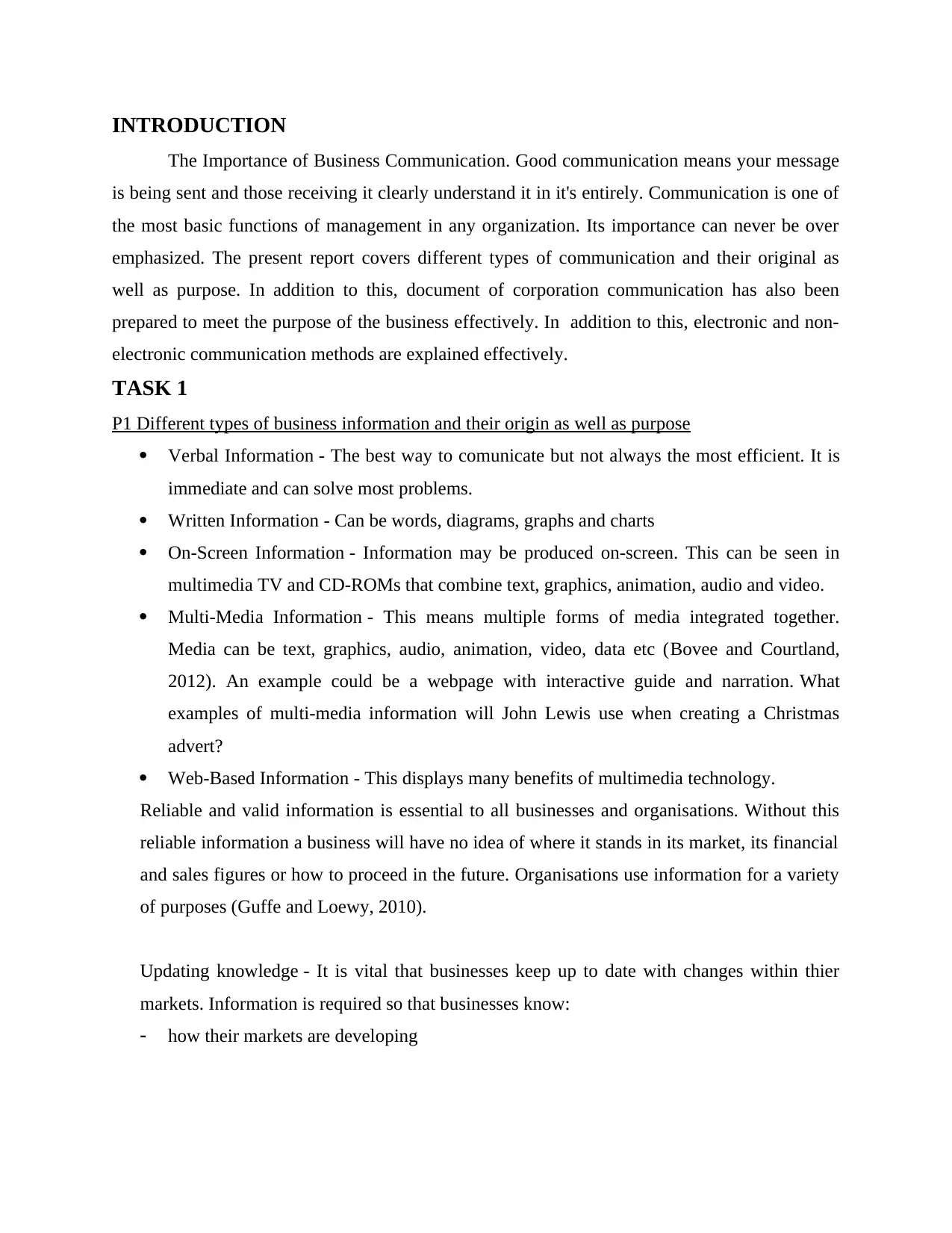
INTRODUCTION
The Importance of Business Communication. Good communication means your message
is being sent and those receiving it clearly understand it in it's entirely. Communication is one of
the most basic functions of management in any organization. Its importance can never be over
emphasized. The present report covers different types of communication and their original as
well as purpose. In addition to this, document of corporation communication has also been
prepared to meet the purpose of the business effectively. In addition to this, electronic and non-
electronic communication methods are explained effectively.
TASK 1
P1 Different types of business information and their origin as well as purpose
Verbal Information - The best way to comunicate but not always the most efficient. It is
immediate and can solve most problems.
Written Information - Can be words, diagrams, graphs and charts
On-Screen Information - Information may be produced on-screen. This can be seen in
multimedia TV and CD-ROMs that combine text, graphics, animation, audio and video.
Multi-Media Information - This means multiple forms of media integrated together.
Media can be text, graphics, audio, animation, video, data etc (Bovee and Courtland,
2012). An example could be a webpage with interactive guide and narration. What
examples of multi-media information will John Lewis use when creating a Christmas
advert?
Web-Based Information - This displays many benefits of multimedia technology.
Reliable and valid information is essential to all businesses and organisations. Without this
reliable information a business will have no idea of where it stands in its market, its financial
and sales figures or how to proceed in the future. Organisations use information for a variety
of purposes (Guffe and Loewy, 2010).
Updating knowledge - It is vital that businesses keep up to date with changes within thier
markets. Information is required so that businesses know:
how their markets are developing
The Importance of Business Communication. Good communication means your message
is being sent and those receiving it clearly understand it in it's entirely. Communication is one of
the most basic functions of management in any organization. Its importance can never be over
emphasized. The present report covers different types of communication and their original as
well as purpose. In addition to this, document of corporation communication has also been
prepared to meet the purpose of the business effectively. In addition to this, electronic and non-
electronic communication methods are explained effectively.
TASK 1
P1 Different types of business information and their origin as well as purpose
Verbal Information - The best way to comunicate but not always the most efficient. It is
immediate and can solve most problems.
Written Information - Can be words, diagrams, graphs and charts
On-Screen Information - Information may be produced on-screen. This can be seen in
multimedia TV and CD-ROMs that combine text, graphics, animation, audio and video.
Multi-Media Information - This means multiple forms of media integrated together.
Media can be text, graphics, audio, animation, video, data etc (Bovee and Courtland,
2012). An example could be a webpage with interactive guide and narration. What
examples of multi-media information will John Lewis use when creating a Christmas
advert?
Web-Based Information - This displays many benefits of multimedia technology.
Reliable and valid information is essential to all businesses and organisations. Without this
reliable information a business will have no idea of where it stands in its market, its financial
and sales figures or how to proceed in the future. Organisations use information for a variety
of purposes (Guffe and Loewy, 2010).
Updating knowledge - It is vital that businesses keep up to date with changes within thier
markets. Information is required so that businesses know:
how their markets are developing
⊘ This is a preview!⊘
Do you want full access?
Subscribe today to unlock all pages.

Trusted by 1+ million students worldwide
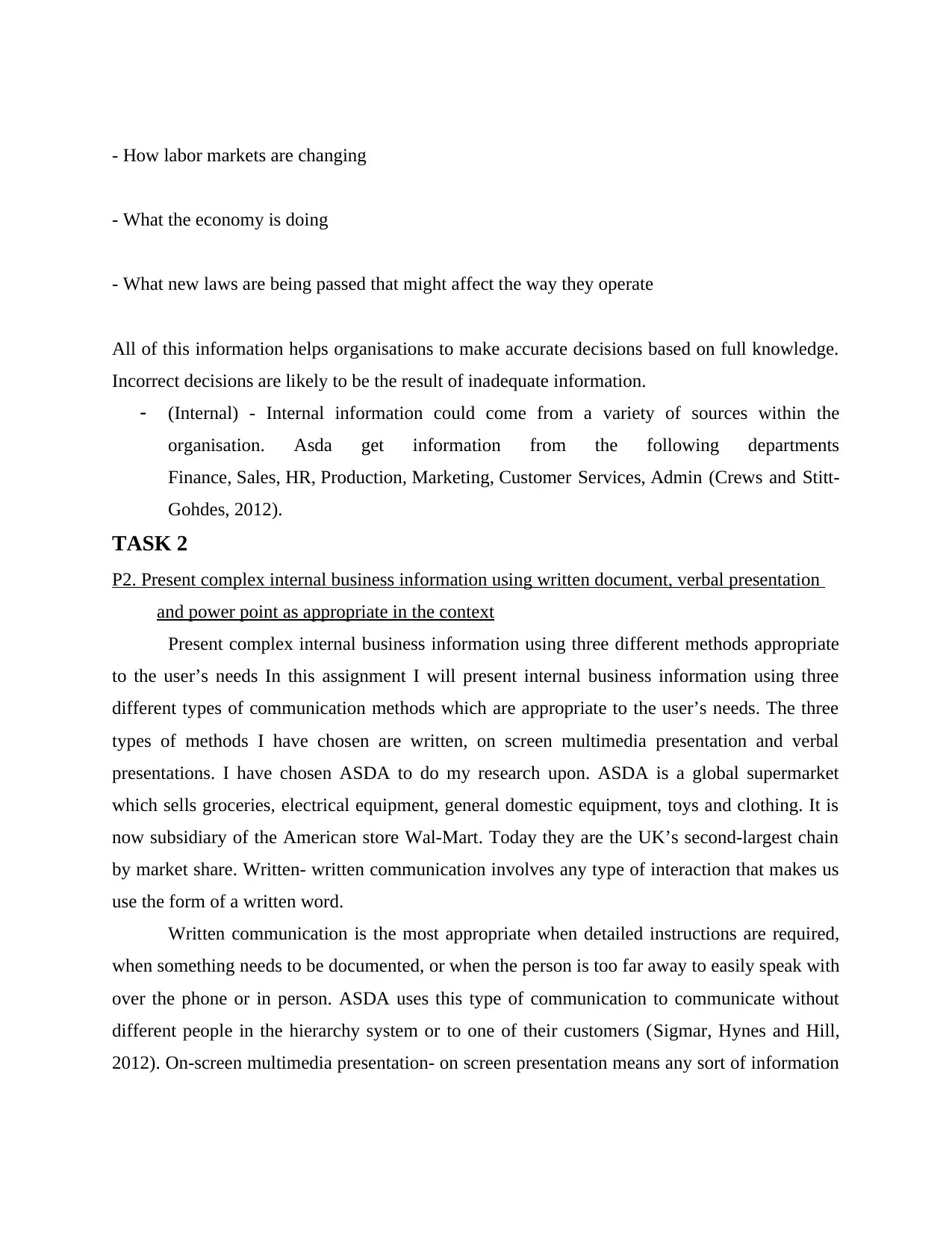
- How labor markets are changing
- What the economy is doing
- What new laws are being passed that might affect the way they operate
All of this information helps organisations to make accurate decisions based on full knowledge.
Incorrect decisions are likely to be the result of inadequate information.
(Internal) - Internal information could come from a variety of sources within the
organisation. Asda get information from the following departments
Finance, Sales, HR, Production, Marketing, Customer Services, Admin (Crews and Stitt-
Gohdes, 2012).
TASK 2
P2. Present complex internal business information using written document, verbal presentation
and power point as appropriate in the context
Present complex internal business information using three different methods appropriate
to the user’s needs In this assignment I will present internal business information using three
different types of communication methods which are appropriate to the user’s needs. The three
types of methods I have chosen are written, on screen multimedia presentation and verbal
presentations. I have chosen ASDA to do my research upon. ASDA is a global supermarket
which sells groceries, electrical equipment, general domestic equipment, toys and clothing. It is
now subsidiary of the American store Wal-Mart. Today they are the UK’s second-largest chain
by market share. Written- written communication involves any type of interaction that makes us
use the form of a written word.
Written communication is the most appropriate when detailed instructions are required,
when something needs to be documented, or when the person is too far away to easily speak with
over the phone or in person. ASDA uses this type of communication to communicate without
different people in the hierarchy system or to one of their customers (Sigmar, Hynes and Hill,
2012). On-screen multimedia presentation- on screen presentation means any sort of information
- What the economy is doing
- What new laws are being passed that might affect the way they operate
All of this information helps organisations to make accurate decisions based on full knowledge.
Incorrect decisions are likely to be the result of inadequate information.
(Internal) - Internal information could come from a variety of sources within the
organisation. Asda get information from the following departments
Finance, Sales, HR, Production, Marketing, Customer Services, Admin (Crews and Stitt-
Gohdes, 2012).
TASK 2
P2. Present complex internal business information using written document, verbal presentation
and power point as appropriate in the context
Present complex internal business information using three different methods appropriate
to the user’s needs In this assignment I will present internal business information using three
different types of communication methods which are appropriate to the user’s needs. The three
types of methods I have chosen are written, on screen multimedia presentation and verbal
presentations. I have chosen ASDA to do my research upon. ASDA is a global supermarket
which sells groceries, electrical equipment, general domestic equipment, toys and clothing. It is
now subsidiary of the American store Wal-Mart. Today they are the UK’s second-largest chain
by market share. Written- written communication involves any type of interaction that makes us
use the form of a written word.
Written communication is the most appropriate when detailed instructions are required,
when something needs to be documented, or when the person is too far away to easily speak with
over the phone or in person. ASDA uses this type of communication to communicate without
different people in the hierarchy system or to one of their customers (Sigmar, Hynes and Hill,
2012). On-screen multimedia presentation- on screen presentation means any sort of information
Paraphrase This Document
Need a fresh take? Get an instant paraphrase of this document with our AI Paraphraser
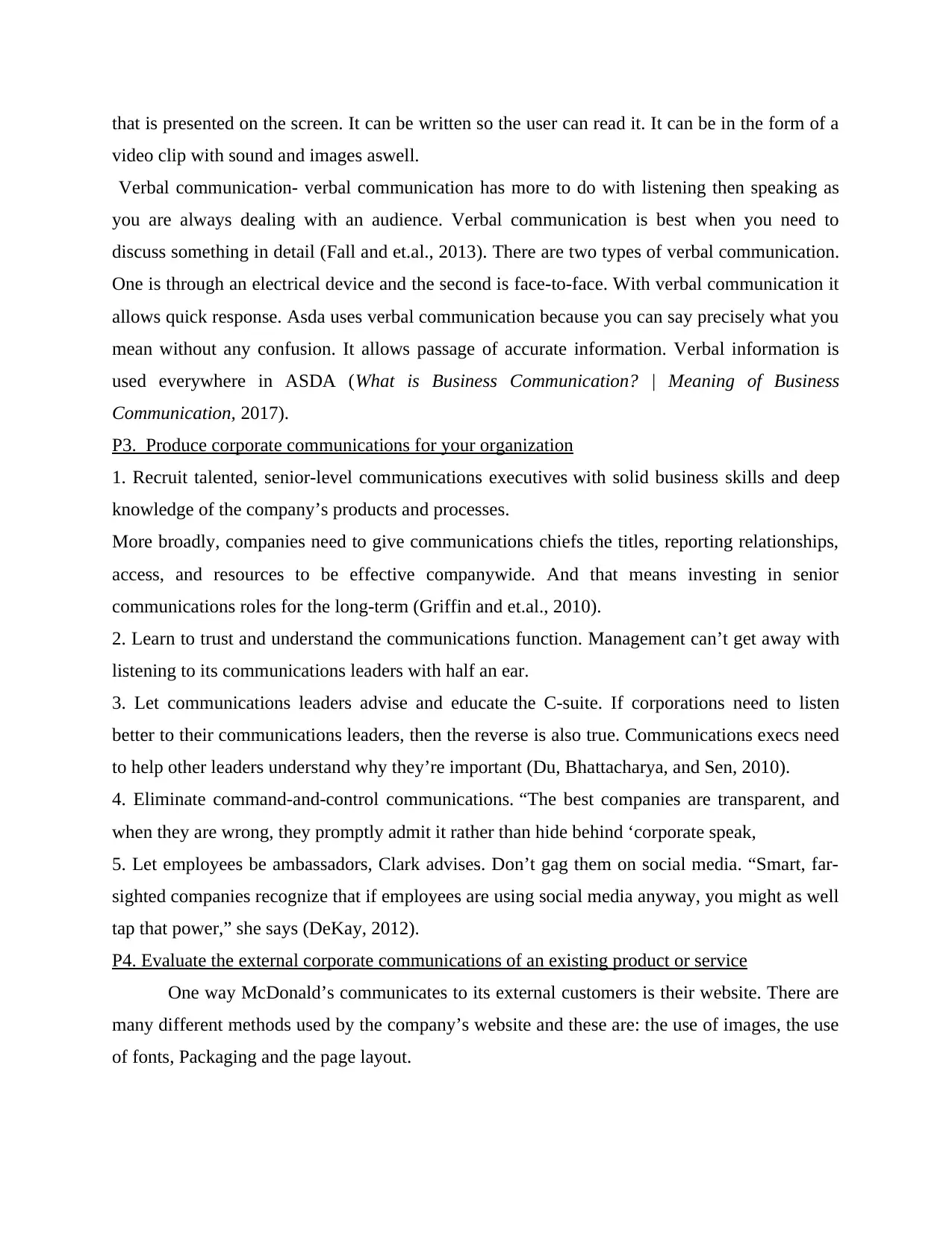
that is presented on the screen. It can be written so the user can read it. It can be in the form of a
video clip with sound and images aswell.
Verbal communication- verbal communication has more to do with listening then speaking as
you are always dealing with an audience. Verbal communication is best when you need to
discuss something in detail (Fall and et.al., 2013). There are two types of verbal communication.
One is through an electrical device and the second is face-to-face. With verbal communication it
allows quick response. Asda uses verbal communication because you can say precisely what you
mean without any confusion. It allows passage of accurate information. Verbal information is
used everywhere in ASDA (What is Business Communication? | Meaning of Business
Communication, 2017).
P3. Produce corporate communications for your organization
1. Recruit talented, senior-level communications executives with solid business skills and deep
knowledge of the company’s products and processes.
More broadly, companies need to give communications chiefs the titles, reporting relationships,
access, and resources to be effective companywide. And that means investing in senior
communications roles for the long-term (Griffin and et.al., 2010).
2. Learn to trust and understand the communications function. Management can’t get away with
listening to its communications leaders with half an ear.
3. Let communications leaders advise and educate the C-suite. If corporations need to listen
better to their communications leaders, then the reverse is also true. Communications execs need
to help other leaders understand why they’re important (Du, Bhattacharya, and Sen, 2010).
4. Eliminate command-and-control communications. “The best companies are transparent, and
when they are wrong, they promptly admit it rather than hide behind ‘corporate speak,
5. Let employees be ambassadors, Clark advises. Don’t gag them on social media. “Smart, far-
sighted companies recognize that if employees are using social media anyway, you might as well
tap that power,” she says (DeKay, 2012).
P4. Evaluate the external corporate communications of an existing product or service
One way McDonald’s communicates to its external customers is their website. There are
many different methods used by the company’s website and these are: the use of images, the use
of fonts, Packaging and the page layout.
video clip with sound and images aswell.
Verbal communication- verbal communication has more to do with listening then speaking as
you are always dealing with an audience. Verbal communication is best when you need to
discuss something in detail (Fall and et.al., 2013). There are two types of verbal communication.
One is through an electrical device and the second is face-to-face. With verbal communication it
allows quick response. Asda uses verbal communication because you can say precisely what you
mean without any confusion. It allows passage of accurate information. Verbal information is
used everywhere in ASDA (What is Business Communication? | Meaning of Business
Communication, 2017).
P3. Produce corporate communications for your organization
1. Recruit talented, senior-level communications executives with solid business skills and deep
knowledge of the company’s products and processes.
More broadly, companies need to give communications chiefs the titles, reporting relationships,
access, and resources to be effective companywide. And that means investing in senior
communications roles for the long-term (Griffin and et.al., 2010).
2. Learn to trust and understand the communications function. Management can’t get away with
listening to its communications leaders with half an ear.
3. Let communications leaders advise and educate the C-suite. If corporations need to listen
better to their communications leaders, then the reverse is also true. Communications execs need
to help other leaders understand why they’re important (Du, Bhattacharya, and Sen, 2010).
4. Eliminate command-and-control communications. “The best companies are transparent, and
when they are wrong, they promptly admit it rather than hide behind ‘corporate speak,
5. Let employees be ambassadors, Clark advises. Don’t gag them on social media. “Smart, far-
sighted companies recognize that if employees are using social media anyway, you might as well
tap that power,” she says (DeKay, 2012).
P4. Evaluate the external corporate communications of an existing product or service
One way McDonald’s communicates to its external customers is their website. There are
many different methods used by the company’s website and these are: the use of images, the use
of fonts, Packaging and the page layout.
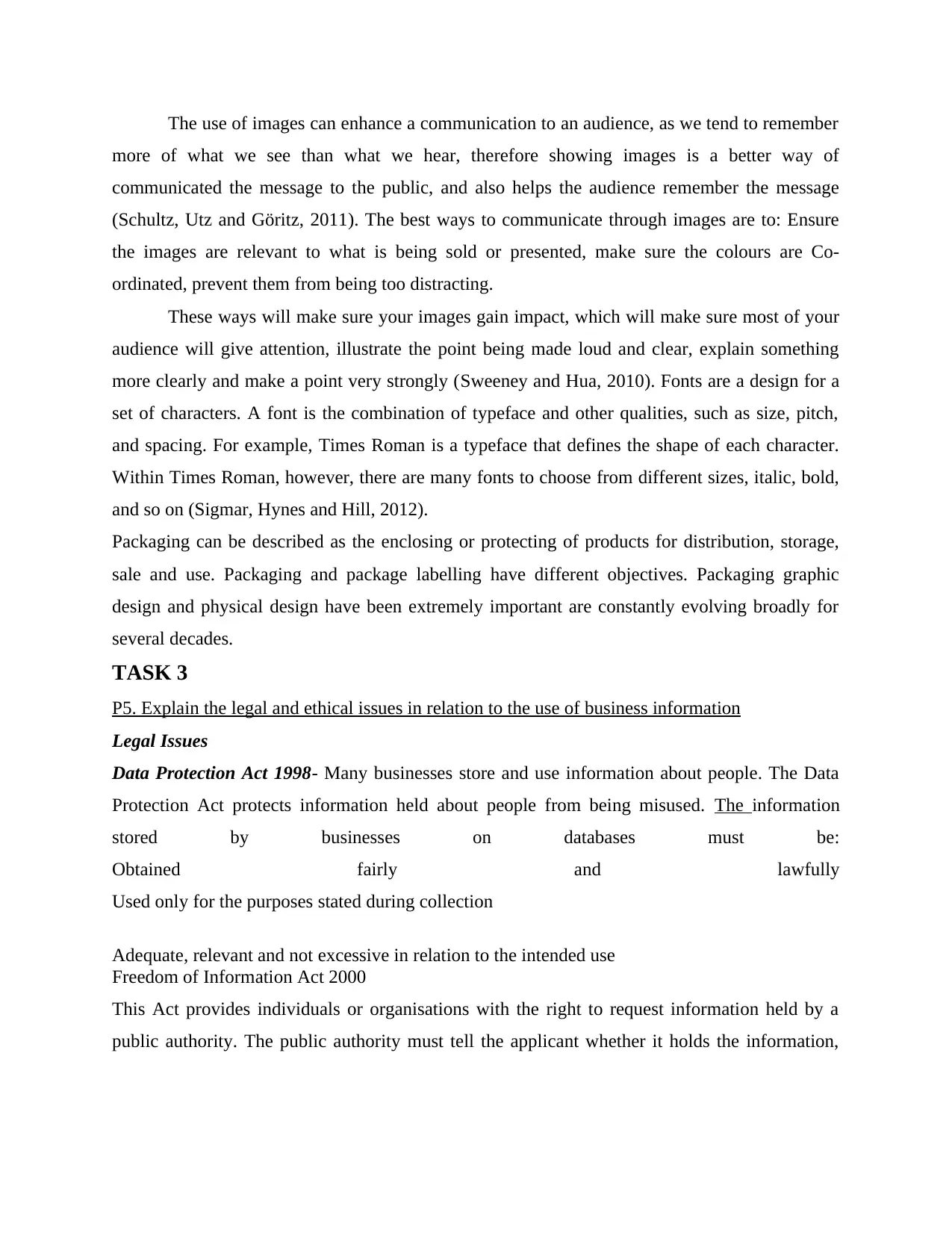
The use of images can enhance a communication to an audience, as we tend to remember
more of what we see than what we hear, therefore showing images is a better way of
communicated the message to the public, and also helps the audience remember the message
(Schultz, Utz and Göritz, 2011). The best ways to communicate through images are to: Ensure
the images are relevant to what is being sold or presented, make sure the colours are Co-
ordinated, prevent them from being too distracting.
These ways will make sure your images gain impact, which will make sure most of your
audience will give attention, illustrate the point being made loud and clear, explain something
more clearly and make a point very strongly (Sweeney and Hua, 2010). Fonts are a design for a
set of characters. A font is the combination of typeface and other qualities, such as size, pitch,
and spacing. For example, Times Roman is a typeface that defines the shape of each character.
Within Times Roman, however, there are many fonts to choose from different sizes, italic, bold,
and so on (Sigmar, Hynes and Hill, 2012).
Packaging can be described as the enclosing or protecting of products for distribution, storage,
sale and use. Packaging and package labelling have different objectives. Packaging graphic
design and physical design have been extremely important are constantly evolving broadly for
several decades.
TASK 3
P5. Explain the legal and ethical issues in relation to the use of business information
Legal Issues
Data Protection Act 1998- Many businesses store and use information about people. The Data
Protection Act protects information held about people from being misused. The information
stored by businesses on databases must be:
Obtained fairly and lawfully
Used only for the purposes stated during collection
Adequate, relevant and not excessive in relation to the intended use
Freedom of Information Act 2000
This Act provides individuals or organisations with the right to request information held by a
public authority. The public authority must tell the applicant whether it holds the information,
more of what we see than what we hear, therefore showing images is a better way of
communicated the message to the public, and also helps the audience remember the message
(Schultz, Utz and Göritz, 2011). The best ways to communicate through images are to: Ensure
the images are relevant to what is being sold or presented, make sure the colours are Co-
ordinated, prevent them from being too distracting.
These ways will make sure your images gain impact, which will make sure most of your
audience will give attention, illustrate the point being made loud and clear, explain something
more clearly and make a point very strongly (Sweeney and Hua, 2010). Fonts are a design for a
set of characters. A font is the combination of typeface and other qualities, such as size, pitch,
and spacing. For example, Times Roman is a typeface that defines the shape of each character.
Within Times Roman, however, there are many fonts to choose from different sizes, italic, bold,
and so on (Sigmar, Hynes and Hill, 2012).
Packaging can be described as the enclosing or protecting of products for distribution, storage,
sale and use. Packaging and package labelling have different objectives. Packaging graphic
design and physical design have been extremely important are constantly evolving broadly for
several decades.
TASK 3
P5. Explain the legal and ethical issues in relation to the use of business information
Legal Issues
Data Protection Act 1998- Many businesses store and use information about people. The Data
Protection Act protects information held about people from being misused. The information
stored by businesses on databases must be:
Obtained fairly and lawfully
Used only for the purposes stated during collection
Adequate, relevant and not excessive in relation to the intended use
Freedom of Information Act 2000
This Act provides individuals or organisations with the right to request information held by a
public authority. The public authority must tell the applicant whether it holds the information,
⊘ This is a preview!⊘
Do you want full access?
Subscribe today to unlock all pages.

Trusted by 1+ million students worldwide
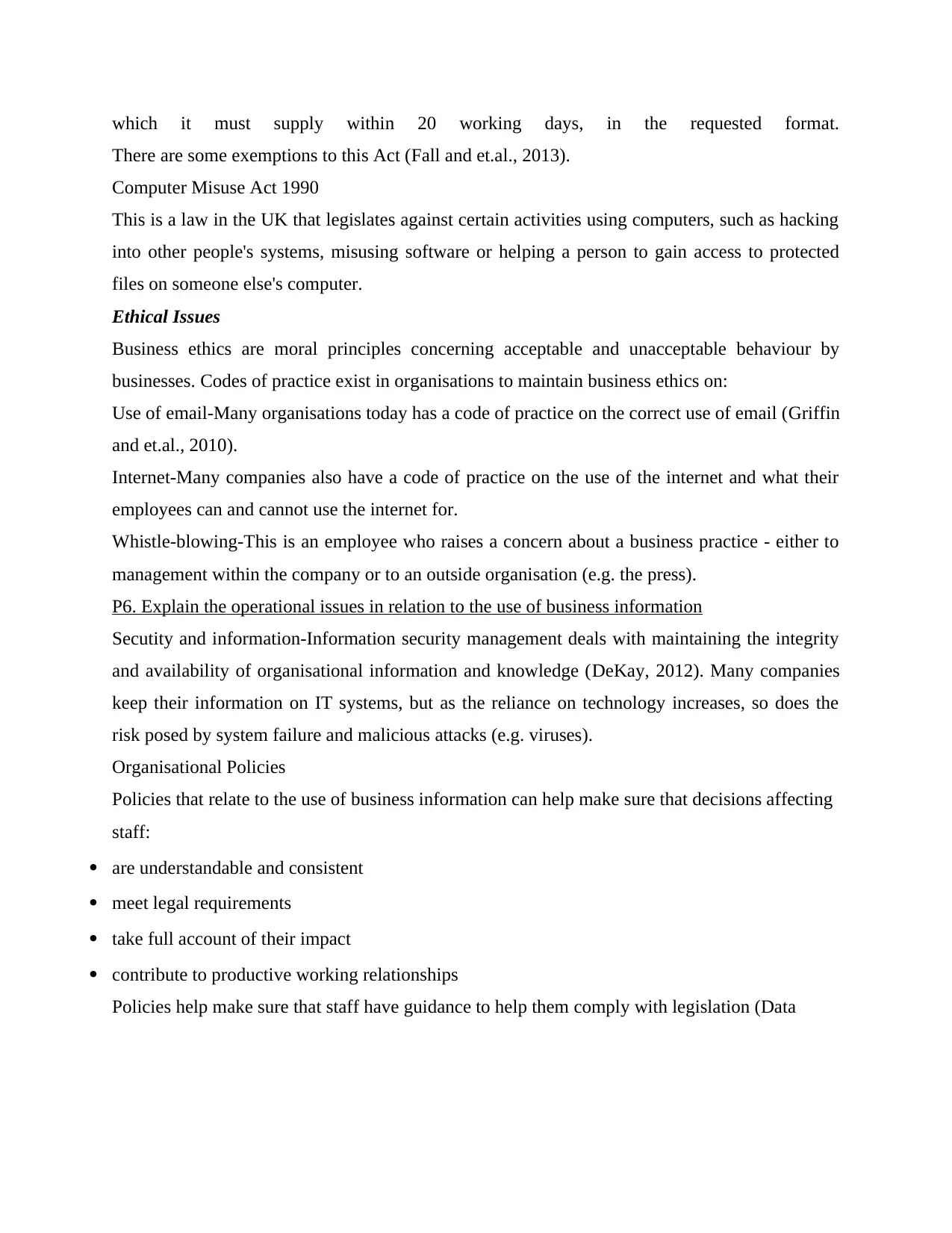
which it must supply within 20 working days, in the requested format.
There are some exemptions to this Act (Fall and et.al., 2013).
Computer Misuse Act 1990
This is a law in the UK that legislates against certain activities using computers, such as hacking
into other people's systems, misusing software or helping a person to gain access to protected
files on someone else's computer.
Ethical Issues
Business ethics are moral principles concerning acceptable and unacceptable behaviour by
businesses. Codes of practice exist in organisations to maintain business ethics on:
Use of email-Many organisations today has a code of practice on the correct use of email (Griffin
and et.al., 2010).
Internet-Many companies also have a code of practice on the use of the internet and what their
employees can and cannot use the internet for.
Whistle-blowing-This is an employee who raises a concern about a business practice - either to
management within the company or to an outside organisation (e.g. the press).
P6. Explain the operational issues in relation to the use of business information
Secutity and information-Information security management deals with maintaining the integrity
and availability of organisational information and knowledge (DeKay, 2012). Many companies
keep their information on IT systems, but as the reliance on technology increases, so does the
risk posed by system failure and malicious attacks (e.g. viruses).
Organisational Policies
Policies that relate to the use of business information can help make sure that decisions affecting
staff:
are understandable and consistent
meet legal requirements
take full account of their impact
contribute to productive working relationships
Policies help make sure that staff have guidance to help them comply with legislation (Data
There are some exemptions to this Act (Fall and et.al., 2013).
Computer Misuse Act 1990
This is a law in the UK that legislates against certain activities using computers, such as hacking
into other people's systems, misusing software or helping a person to gain access to protected
files on someone else's computer.
Ethical Issues
Business ethics are moral principles concerning acceptable and unacceptable behaviour by
businesses. Codes of practice exist in organisations to maintain business ethics on:
Use of email-Many organisations today has a code of practice on the correct use of email (Griffin
and et.al., 2010).
Internet-Many companies also have a code of practice on the use of the internet and what their
employees can and cannot use the internet for.
Whistle-blowing-This is an employee who raises a concern about a business practice - either to
management within the company or to an outside organisation (e.g. the press).
P6. Explain the operational issues in relation to the use of business information
Secutity and information-Information security management deals with maintaining the integrity
and availability of organisational information and knowledge (DeKay, 2012). Many companies
keep their information on IT systems, but as the reliance on technology increases, so does the
risk posed by system failure and malicious attacks (e.g. viruses).
Organisational Policies
Policies that relate to the use of business information can help make sure that decisions affecting
staff:
are understandable and consistent
meet legal requirements
take full account of their impact
contribute to productive working relationships
Policies help make sure that staff have guidance to help them comply with legislation (Data
Paraphrase This Document
Need a fresh take? Get an instant paraphrase of this document with our AI Paraphraser
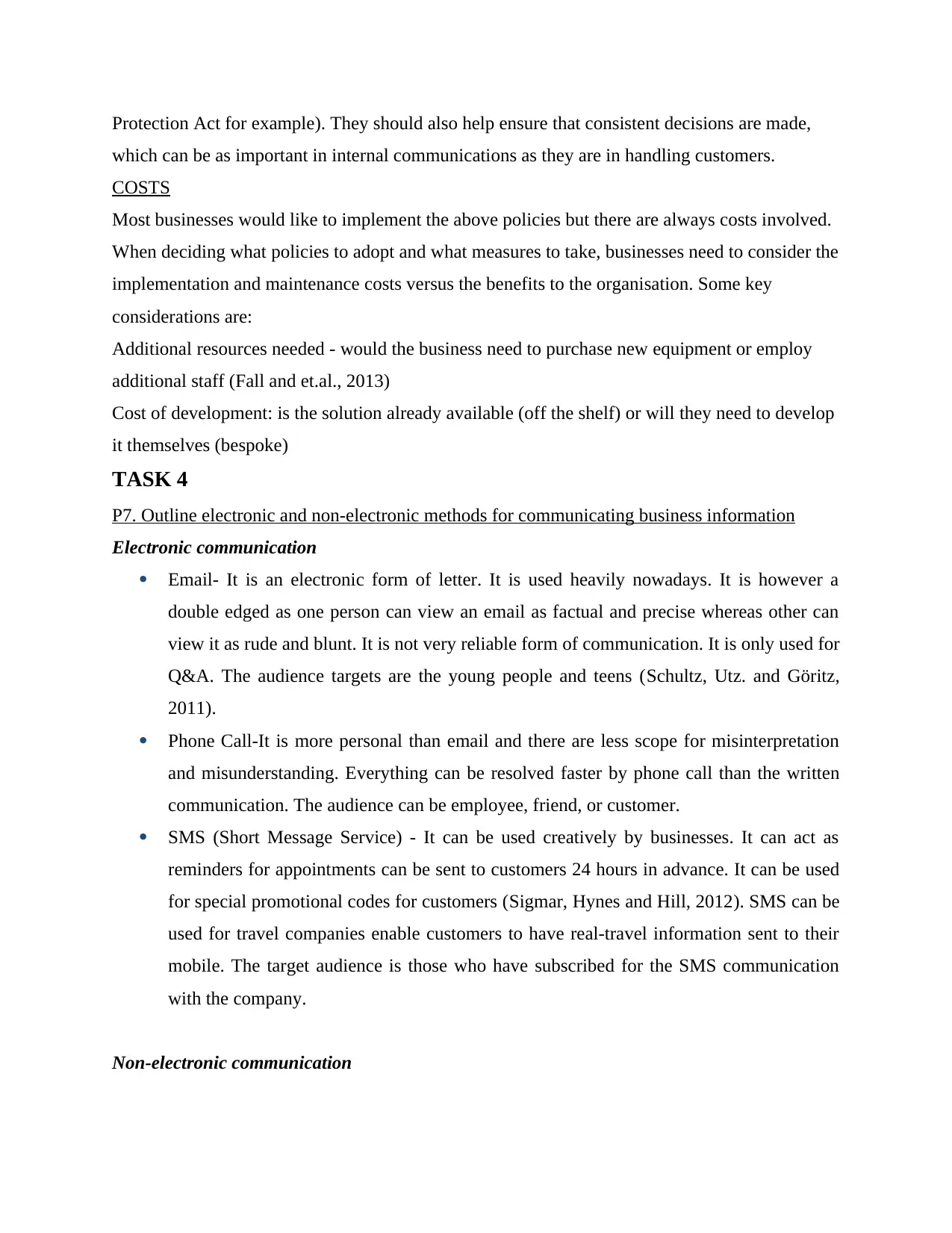
Protection Act for example). They should also help ensure that consistent decisions are made,
which can be as important in internal communications as they are in handling customers.
COSTS
Most businesses would like to implement the above policies but there are always costs involved.
When deciding what policies to adopt and what measures to take, businesses need to consider the
implementation and maintenance costs versus the benefits to the organisation. Some key
considerations are:
Additional resources needed - would the business need to purchase new equipment or employ
additional staff (Fall and et.al., 2013)
Cost of development: is the solution already available (off the shelf) or will they need to develop
it themselves (bespoke)
TASK 4
P7. Outline electronic and non-electronic methods for communicating business information
Electronic communication
Email- It is an electronic form of letter. It is used heavily nowadays. It is however a
double edged as one person can view an email as factual and precise whereas other can
view it as rude and blunt. It is not very reliable form of communication. It is only used for
Q&A. The audience targets are the young people and teens (Schultz, Utz. and Göritz,
2011).
Phone Call-It is more personal than email and there are less scope for misinterpretation
and misunderstanding. Everything can be resolved faster by phone call than the written
communication. The audience can be employee, friend, or customer.
SMS (Short Message Service) - It can be used creatively by businesses. It can act as
reminders for appointments can be sent to customers 24 hours in advance. It can be used
for special promotional codes for customers (Sigmar, Hynes and Hill, 2012). SMS can be
used for travel companies enable customers to have real-travel information sent to their
mobile. The target audience is those who have subscribed for the SMS communication
with the company.
Non-electronic communication
which can be as important in internal communications as they are in handling customers.
COSTS
Most businesses would like to implement the above policies but there are always costs involved.
When deciding what policies to adopt and what measures to take, businesses need to consider the
implementation and maintenance costs versus the benefits to the organisation. Some key
considerations are:
Additional resources needed - would the business need to purchase new equipment or employ
additional staff (Fall and et.al., 2013)
Cost of development: is the solution already available (off the shelf) or will they need to develop
it themselves (bespoke)
TASK 4
P7. Outline electronic and non-electronic methods for communicating business information
Electronic communication
Email- It is an electronic form of letter. It is used heavily nowadays. It is however a
double edged as one person can view an email as factual and precise whereas other can
view it as rude and blunt. It is not very reliable form of communication. It is only used for
Q&A. The audience targets are the young people and teens (Schultz, Utz. and Göritz,
2011).
Phone Call-It is more personal than email and there are less scope for misinterpretation
and misunderstanding. Everything can be resolved faster by phone call than the written
communication. The audience can be employee, friend, or customer.
SMS (Short Message Service) - It can be used creatively by businesses. It can act as
reminders for appointments can be sent to customers 24 hours in advance. It can be used
for special promotional codes for customers (Sigmar, Hynes and Hill, 2012). SMS can be
used for travel companies enable customers to have real-travel information sent to their
mobile. The target audience is those who have subscribed for the SMS communication
with the company.
Non-electronic communication
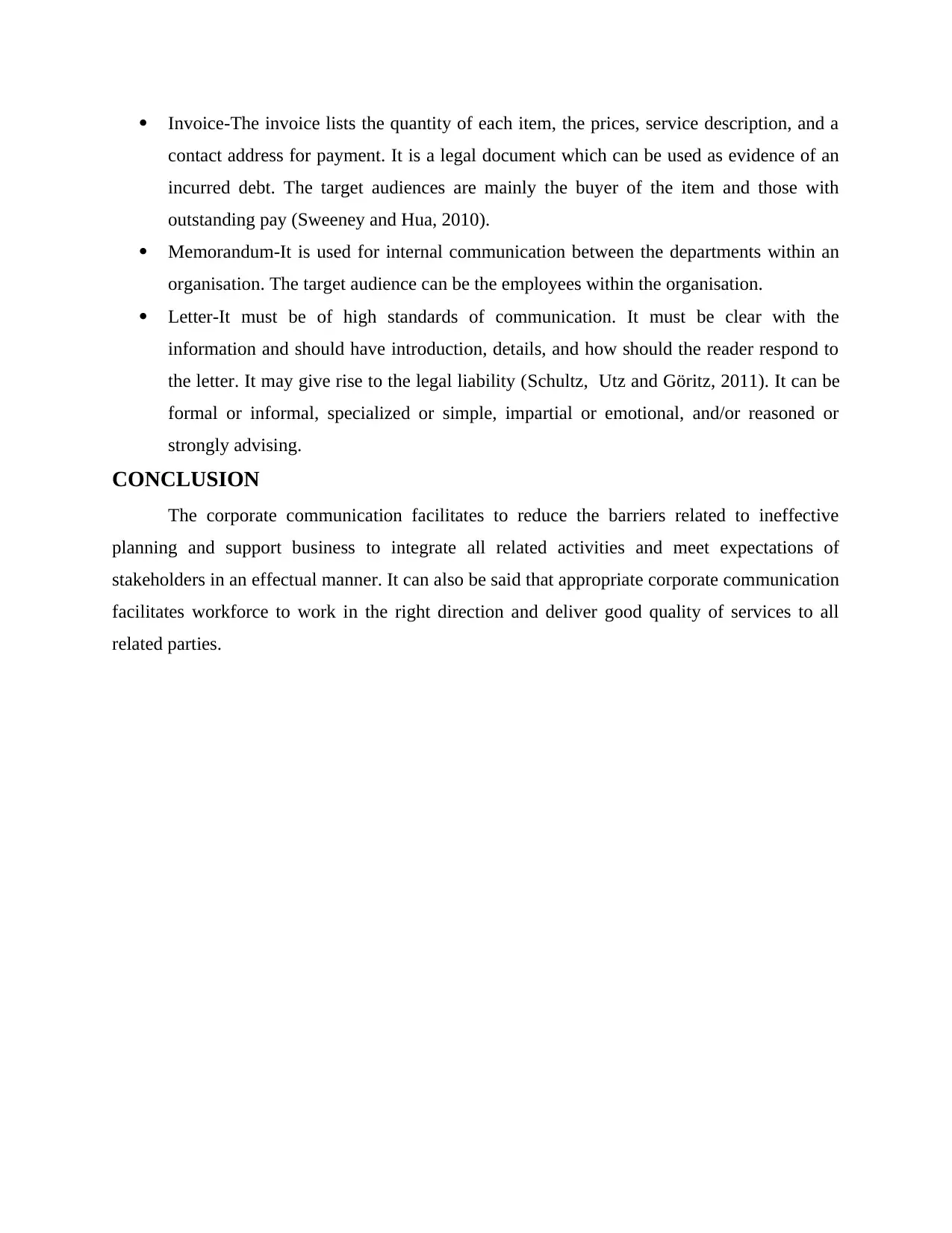
Invoice-The invoice lists the quantity of each item, the prices, service description, and a
contact address for payment. It is a legal document which can be used as evidence of an
incurred debt. The target audiences are mainly the buyer of the item and those with
outstanding pay (Sweeney and Hua, 2010).
Memorandum-It is used for internal communication between the departments within an
organisation. The target audience can be the employees within the organisation.
Letter-It must be of high standards of communication. It must be clear with the
information and should have introduction, details, and how should the reader respond to
the letter. It may give rise to the legal liability (Schultz, Utz and Göritz, 2011). It can be
formal or informal, specialized or simple, impartial or emotional, and/or reasoned or
strongly advising.
CONCLUSION
The corporate communication facilitates to reduce the barriers related to ineffective
planning and support business to integrate all related activities and meet expectations of
stakeholders in an effectual manner. It can also be said that appropriate corporate communication
facilitates workforce to work in the right direction and deliver good quality of services to all
related parties.
contact address for payment. It is a legal document which can be used as evidence of an
incurred debt. The target audiences are mainly the buyer of the item and those with
outstanding pay (Sweeney and Hua, 2010).
Memorandum-It is used for internal communication between the departments within an
organisation. The target audience can be the employees within the organisation.
Letter-It must be of high standards of communication. It must be clear with the
information and should have introduction, details, and how should the reader respond to
the letter. It may give rise to the legal liability (Schultz, Utz and Göritz, 2011). It can be
formal or informal, specialized or simple, impartial or emotional, and/or reasoned or
strongly advising.
CONCLUSION
The corporate communication facilitates to reduce the barriers related to ineffective
planning and support business to integrate all related activities and meet expectations of
stakeholders in an effectual manner. It can also be said that appropriate corporate communication
facilitates workforce to work in the right direction and deliver good quality of services to all
related parties.
⊘ This is a preview!⊘
Do you want full access?
Subscribe today to unlock all pages.

Trusted by 1+ million students worldwide
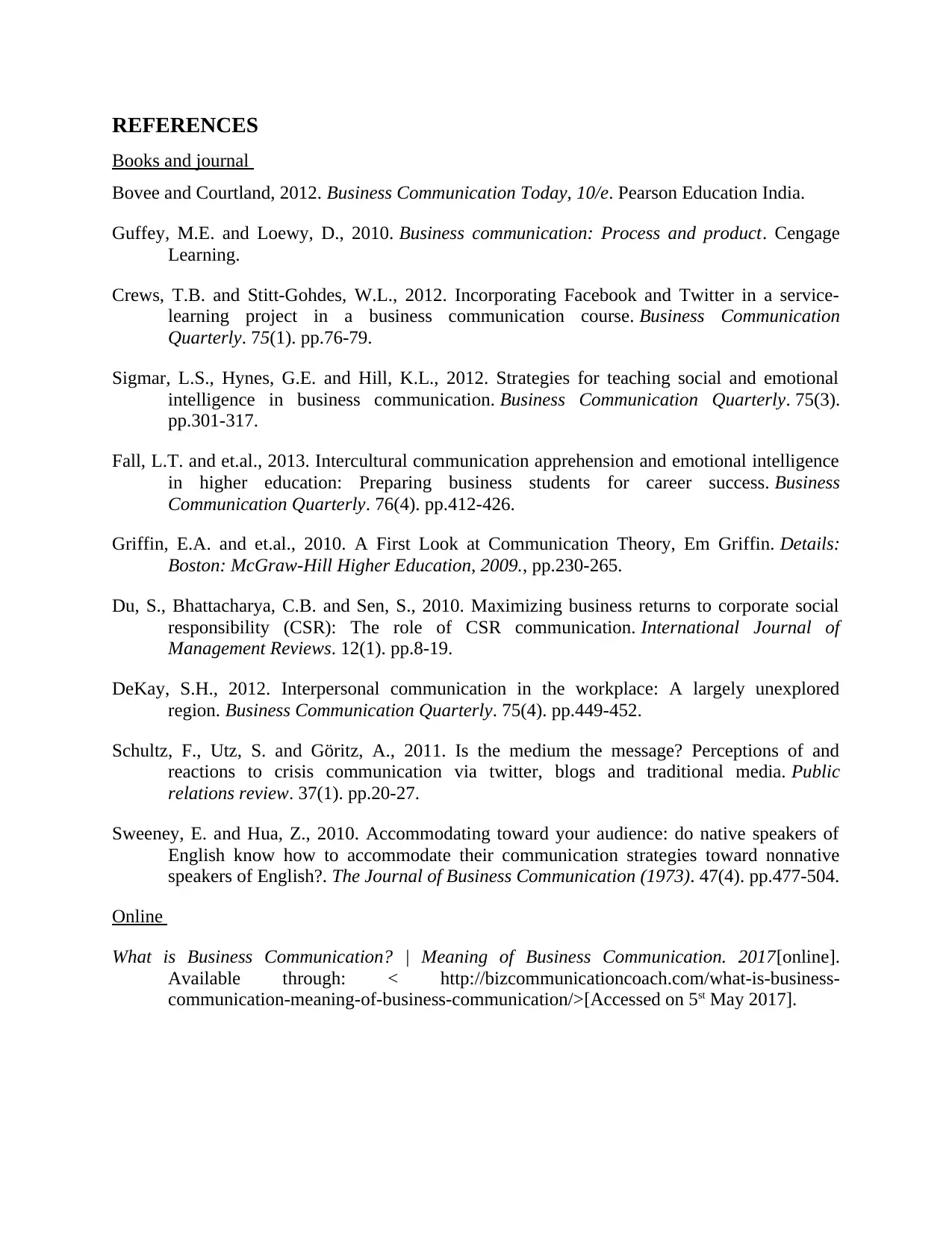
REFERENCES
Books and journal
Bovee and Courtland, 2012. Business Communication Today, 10/e. Pearson Education India.
Guffey, M.E. and Loewy, D., 2010. Business communication: Process and product. Cengage
Learning.
Crews, T.B. and Stitt-Gohdes, W.L., 2012. Incorporating Facebook and Twitter in a service-
learning project in a business communication course. Business Communication
Quarterly. 75(1). pp.76-79.
Sigmar, L.S., Hynes, G.E. and Hill, K.L., 2012. Strategies for teaching social and emotional
intelligence in business communication. Business Communication Quarterly. 75(3).
pp.301-317.
Fall, L.T. and et.al., 2013. Intercultural communication apprehension and emotional intelligence
in higher education: Preparing business students for career success. Business
Communication Quarterly. 76(4). pp.412-426.
Griffin, E.A. and et.al., 2010. A First Look at Communication Theory, Em Griffin. Details:
Boston: McGraw-Hill Higher Education, 2009., pp.230-265.
Du, S., Bhattacharya, C.B. and Sen, S., 2010. Maximizing business returns to corporate social
responsibility (CSR): The role of CSR communication. International Journal of
Management Reviews. 12(1). pp.8-19.
DeKay, S.H., 2012. Interpersonal communication in the workplace: A largely unexplored
region. Business Communication Quarterly. 75(4). pp.449-452.
Schultz, F., Utz, S. and Göritz, A., 2011. Is the medium the message? Perceptions of and
reactions to crisis communication via twitter, blogs and traditional media. Public
relations review. 37(1). pp.20-27.
Sweeney, E. and Hua, Z., 2010. Accommodating toward your audience: do native speakers of
English know how to accommodate their communication strategies toward nonnative
speakers of English?. The Journal of Business Communication (1973). 47(4). pp.477-504.
Online
What is Business Communication? | Meaning of Business Communication. 2017[online].
Available through: < http://bizcommunicationcoach.com/what-is-business-
communication-meaning-of-business-communication/>[Accessed on 5st May 2017].
Books and journal
Bovee and Courtland, 2012. Business Communication Today, 10/e. Pearson Education India.
Guffey, M.E. and Loewy, D., 2010. Business communication: Process and product. Cengage
Learning.
Crews, T.B. and Stitt-Gohdes, W.L., 2012. Incorporating Facebook and Twitter in a service-
learning project in a business communication course. Business Communication
Quarterly. 75(1). pp.76-79.
Sigmar, L.S., Hynes, G.E. and Hill, K.L., 2012. Strategies for teaching social and emotional
intelligence in business communication. Business Communication Quarterly. 75(3).
pp.301-317.
Fall, L.T. and et.al., 2013. Intercultural communication apprehension and emotional intelligence
in higher education: Preparing business students for career success. Business
Communication Quarterly. 76(4). pp.412-426.
Griffin, E.A. and et.al., 2010. A First Look at Communication Theory, Em Griffin. Details:
Boston: McGraw-Hill Higher Education, 2009., pp.230-265.
Du, S., Bhattacharya, C.B. and Sen, S., 2010. Maximizing business returns to corporate social
responsibility (CSR): The role of CSR communication. International Journal of
Management Reviews. 12(1). pp.8-19.
DeKay, S.H., 2012. Interpersonal communication in the workplace: A largely unexplored
region. Business Communication Quarterly. 75(4). pp.449-452.
Schultz, F., Utz, S. and Göritz, A., 2011. Is the medium the message? Perceptions of and
reactions to crisis communication via twitter, blogs and traditional media. Public
relations review. 37(1). pp.20-27.
Sweeney, E. and Hua, Z., 2010. Accommodating toward your audience: do native speakers of
English know how to accommodate their communication strategies toward nonnative
speakers of English?. The Journal of Business Communication (1973). 47(4). pp.477-504.
Online
What is Business Communication? | Meaning of Business Communication. 2017[online].
Available through: < http://bizcommunicationcoach.com/what-is-business-
communication-meaning-of-business-communication/>[Accessed on 5st May 2017].
Paraphrase This Document
Need a fresh take? Get an instant paraphrase of this document with our AI Paraphraser

1 out of 11
Related Documents
Your All-in-One AI-Powered Toolkit for Academic Success.
+13062052269
info@desklib.com
Available 24*7 on WhatsApp / Email
![[object Object]](/_next/static/media/star-bottom.7253800d.svg)
Unlock your academic potential
Copyright © 2020–2025 A2Z Services. All Rights Reserved. Developed and managed by ZUCOL.





